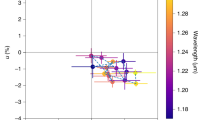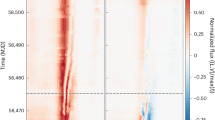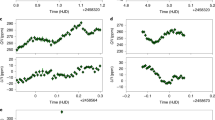Abstract
The gravitational-wave event GW 170817 was generated by the coalescence of two neutron stars and produced an electromagnetic transient, labelled AT 2017gfo, that was the target of a massive observational campaign. Polarimetry is a powerful diagnostic tool for probing the geometry and emission processes of unresolved sources, and the observed linear polarization for this event was consistent with being mostly induced by intervening dust, suggesting that the intrinsic emission was weakly polarized (P < 0.4–0.5%). Here we present a detailed analysis of the linear polarization expected from a merging neutron-star binary system by means of 3D Monte Carlo radiative transfer simulations assuming a range of possible configurations, wavelengths, epochs and viewing angles. We find that polarization originates from the non-homogeneous opacity distribution within the ejecta and can reach levels of 1% at early times (one to two days after the merger) and in the optical R band. Smaller polarization signals are expected at later epochs and different wavelengths. From the viewing-angle dependence of the polarimetric signal, we constrain the observer orientation of AT 2017gfo to within about 65° from the polar direction. The detection of non-zero polarization in future events will unambiguously reveal the presence of a lanthanide-free ejecta component and unveil its spatial and angular distribution.
This is a preview of subscription content, access via your institution
Access options
Access Nature and 54 other Nature Portfolio journals
Get Nature+, our best-value online-access subscription
$29.99 / 30 days
cancel any time
Subscribe to this journal
Receive 12 digital issues and online access to articles
$119.00 per year
only $9.92 per issue
Buy this article
- Purchase on Springer Link
- Instant access to full article PDF
Prices may be subject to local taxes which are calculated during checkout






Similar content being viewed by others
References
Abbott, B. P. et al. GW170817: observation of gravitational waves from a binary neutron star inspiral. Phys. Rev. Lett. 119, 161101 (2017).
Abbott, B. P. et al. Multi-messenger observations of a binary neutron star merger. Astrophys. J. 848, L12 (2017).
Mooley, K. P. et al. Superluminal motion of a relativistic jet in the neutron star merger GW170817. Preprint at https://arxiv.org/abs/1806.09693 (2018).
Ghirlanda, G. et al. Re-solving the jet/cocoon riddle of the first gravitational wave with an electromagnetic counterpart. Preprint at https://arxiv.org/abs/1808.00469 (2018).
Covino, S. et al. The unpolarized macronova associated with the gravitational wave event GW 170817. Nature Astron. 1, 791–794 (2017).
Evans, P. A. et al. Swift and NuSTAR observations of GW170817: detection of a blue kilonova. Science 358, 1565–1570 (2017).
Pian, E. et al. Spectroscopic identification of r-process nucleosynthesis in a double neutron-star merger. Nature 551, 67–70 (2017).
Smartt, S. J. et al. A kilonova as the electromagnetic counterpart to a gravitational-wave source. Nature 551, 75–79 (2017).
Tanvir, N. R. et al. The emergence of a lanthanide-rich kilonova following the merger of two neutron stars. Astrophys. J. 848, L27 (2017).
Li, L.-X. & Paczyński, B. Transient events from neutron star mergers. Astrophys. J. 507, L59–L62 (1998).
Metzger, B. D. et al. Electromagnetic counterparts of compact object mergers powered by the radioactive decay of r-process nuclei. Mon. Not. R. Astron. Soc. 406, 2650–2662 (2010).
Roberts, L. F., Kasen, D., Lee, W. H. & Ramirez-Ruiz, E. Electromagnetic transients powered by nuclear decay in the tidal tails of coalescing compact binaries. Astrophys. J. 736, L21 (2011).
Kasen, D., Badnell, N. R. & Barnes, J. Opacities and spectra of the r-process ejecta from neutron star mergers. Astrophys. J. 774, 25 (2013).
Barnes, J. & Kasen, D. Effect of a high opacity on the light curves of radioactively powered transients from compact object mergers. Astrophys. J. 775, 18 (2013).
Tanaka, M. & Hotokezaka, K. Radiative transfer simulations of neutron star merger ejecta. Astrophys. J. 775, 113 (2013).
Baiotti, L. & Rezzolla, L. Binary neutron star mergers: a review of Einstein’s richest laboratory. Rep. Prog. Phys. 80, 096901 (2017).
Metzger, B. D. Kilonovae. Liv. Rev. Rel. 20, 3 (2017).
Tanaka, M. et al. Kilonova from post-merger ejecta as an optical and near-Infrared counterpart of GW170817. PASJ 69, 102 (2017).
Tanaka, M. et al. Properties of kilonovae from dynamical and post-merger ejecta of neutron star mergers. Astrophys. J. 852, 109 (2018).
Kyutoku, K., Ioka, K. & Shibata, M. Anisotropic mass ejection from black hole-neutron star binaries: diversity of electromagnetic counterparts. Phys. Rev. D 88, 041503 (2013).
Kyutoku, K., Ioka, K., Okawa, H., Shibata, M. & Taniguchi, K. Dynamical mass ejection from black hole-neutron star binaries. Phys. Rev. D 92, 044028 (2015).
Hotokezaka, K. et al. Mass ejection from the merger of binary neutron stars. Phys. Rev. D 87, 024001 (2013).
Bauswein, A., Goriely, S. & Janka, H.-T. Systematics of dynamical mass ejection, nucleosynthesis, and radioactively powered electromagnetic signals from neutron-star mergers. Astrophys. J. 773, 78 (2013).
Fernández, R. & Metzger, B. D. Delayed outflows from black hole accretion tori following neutron star binary coalescence. Mon. Not. R. Astron. Soc. 435, 502–517 (2013).
Siegel, D. M. & Metzger, B. D. Three-dimensional general-relativistic magnetohydrodynamic simulations of remnant accretion disks from neutron star mergers: outflows and r-process nucleosynthesis. Phys. Rev. Lett. 119, 231102 (2017).
Shibata, M., Kiuchi, K. & Sekiguchi, Y.-i General relativistic viscous hydrodynamics of differentially rotating neutron stars. Phys. Rev. D 95, 083005 (2017).
Fujibayashi, S., Sekiguchi, Y., Kiuchi, K. & Shibata, M. Properties of neutrino-driven ejecta from the remnant of binary neutron star merger: purely radiation hydrodynamics case. Preprint at https://arxiv.org/abs/1703.10191 (2017).
Metzger, B. D. & Fernández, R. Red or blue? A potential kilonova imprint of the delay until black hole formation following a neutron star merger. Mon. Not. R. Astron. Soc. 441, 3444–3453 (2014).
Lippuner, J. et al. Signatures of hypermassive neutron star lifetimes on r-process nucleosynthesis in the disc ejecta from neutron star mergers. Mon. Not. R. Astron. Soc. 472, 904–918 (2017).
Perego, A. et al. Neutrino-driven winds from neutron star merger remnants. Mon. Not. R. Astron. Soc. 443, 3134–3156 (2014).
Chornock, R. et al. The electromagnetic counterpart of the binary neutron star merger LIGO/Virgo GW170817. IV. Detection of near-infrared signatures of r-process nucleosynthesis with gemini-south. Astrophys. J. 848, L19 (2017).
Cowperthwaite, P. S. et al. The electromagnetic counterpart of the binary neutron star merger LIGO/Virgo GW170817. II. UV, optical, and near-infrared light curves and comparison to kilonova models. Astrophys. J. 848, L17 (2017).
Nicholl, M. et al. The electromagnetic counterpart of the binary neutron star merger LIGO/Virgo GW170817. III. optical and UV spectra of a blue kilonova from fast polar ejecta. Astrophys. J. 848, L18 (2017).
Bulla, M., Sim, S. A. & Kromer, M. Polarization spectral synthesis for type Ia supernova explosion models. Mon. Not. R. Astron. Soc. 450, 967–981 (2015).
Bulla, M. Polarisation Spectral Synthesis For Type Ia Supernova Explosion Models PhD thesis, Queen’s University Belfast (2017).
Serkowski, K., Mathewson, D. S. & Ford, V. L. Wavelength dependence of interstellar polarization and ratio of total to selective extinction. Astrophys. J. 196, 261–290 (1975).
Wang, L. & Wheeler, J. C. Spectropolarimetry of Supernovae. Ann. Rev. Astron. Astrophys. 46, 433–474 (2008).
Maund, J. R. et al. Spectropolarimetry of the type IIb Supernova 2001ig. Astrophys. J. 671, 1944–1958 (2007).
Patat, F. et al. VLT Spectropolarimetry of the type Ia SN 2005ke. A step towards understanding subluminous events. Astron. Astrophys. 545, A7 (2012).
Troja, E. et al. The X-ray counterpart to the gravitational-wave event GW 170817. Nature 551, 71–74 (2017).
Finstad, D., De, S., Brown, D. A., Berger, E. & Biwer, C. M. Measuring the viewing angle of GW170817 with electromagnetic and gravitational waves. Preprint at https://arxiv.org/abs/1804.04179 (2018).
Mandel, I. The orbit of GW170817 was inclined by less than 28 deg to the line of sight. Astrophys. J. 853, L12 (2018).
Metzger, B. D., Thompson, T. A. & Quataert, E. A magnetar origin for the kilonova ejecta in GW170817. Astrophys. J. 856, 101 (2018).
D’Avanzo, P. et al. The evolution of the X-ray afterglow emission of GW 170817 / GRB 170817A in XMM-Newton observations. Preprint at https://arxiv.org/abs/1801.06164 (2018).
Kasen, D., Fernández, R. & Metzger, B. D. Kilonova light curves from the disc wind outflows of compact object mergers. Mon. Not. R. Astron. Soc. 450, 1777–1786 (2015).
Kasen, D., Metzger, B., Barnes, J., Quataert, E. & Ramirez-Ruiz, E. Origin of the heavy elements in binary neutron-star mergers from a gravitational-wave event. Nature 551, 80–84 (2017).
Shibata, M. et al. Modeling GW170817 based on numerical relativity and its implications. Phys. Rev. D 96, 123012 (2017).
Inserra, C., Bulla, M., Sim, S. A. & Smartt, S. J. Spectropolarimetry of superluminous supernovae: insight into their geometry. Astrophys. J. 831, 79 (2016).
Jeffery, D. J. The Sobolev-P method—a generalization of the Sobolev method for the treatment of the polarization state of radiation and the polarizing effect of resonance line scattering. Astrophys. J. Suppl. Ser. 71, 951–981 (1989).
Mazzali, P. A. & Lucy, L. B. The application of Monte Carlo methods to the synthesis of early-time supernovae spectra. Astron. Astrophys. 279, 447–456 (1993).
Chandrasekhar, S. Radiative Transfer (Dover Publications, New York, 1960).
Code, A. D. & Whitney, B. A. Polarization from scattering in blobs. Astrophys. J. 441, 400–407 (1995).
Wang, L., Wheeler, J. C. & Höflich, P. Polarimetry of the type IA supernova SN 1996X. Astrophys. J. 476, L27–L30 (1997).
Hoflich, P. Asphericity effects in scattering dominated photospheres. Astron. Astrophys. 246, 481 (1991).
Martin, D. et al. Neutrino-driven winds in the aftermath of a neutron star merger: nucleosynthesis and electromagnetic transients. Astrophys. J. 813, 2 (2015).
Bovard, L. et al. r -process nucleosynthesis from matter ejected in binary neutron star mergers. Phys. Rev. D 96, 124005 (2017).
Hillier, D. J. The calculation of continuum polarization due to the Rayleigh scattering phase matrix in multi-scattering axisymmetric envelopes. Astron. Astrophys. 289, 492–504 (1994).
Wood, K., Bjorkman, J. E., Whitney, B. & Code, A. The effect of multiple scattering on the polarization from axisymmetric circumstellar envelopes. II. Thomson scattering in the presence of absorptive opacity sources. Astrophys. J. 461, 847 (1996).
Kasen, D. et al. Analysis of the flux and polarization spectra of the type Ia supernova SN 2001el: exploring the geometry of the high-velocity ejecta. Astrophys. J. 593, 788–808 (2003).
Dessart, L. & Hillier, D. J. Synthetic line and continuum linear-polarization signatures of axisymmetric type II supernova ejecta. Mon. Not. R. Astron. Soc. 415, 3497–3519 (2011).
Kasen, D., Nugent, P., Thomas, R. C. & Wang, L. Could there be a hole in type Ia supernovae? Astrophys. J. 610, 876–887 (2004).
Bulla, M. et al. Predicting polarization signatures for double-detonation and delayed-detonation models of type Ia supernovae. Mon. Not. R. Astron. Soc. 462, 1039–1056 (2016).
Plaszczynski, S., Montier, L., Levrier, F. & Tristram, M. A novel estimator of the polarization amplitude from normally distributed Stokes parameters. Mon. Not. R. Astron. Soc. 439, 4048–4056 (2014).
Acknowledgements
M.B. acknowledges support from the Swedish Research Council (Vetenskapsrå det) and the Swedish National Space Board. S.C. acknowledges support from ASI grant I/004/11/3 and partial financial support by the GRAWITA collaboration. K.K. is supported by the Japanese Society for the Promotion of Science (JSPS) Kakenhi Grant-in-Aid for Scientific Research (grant numbers JP16H06342, JP17H01131 and JP18H04595). J.R.M. is supported through a Royal Society University Research Fellowship. K.T. is supported by JSPS Kakenhi grant numbers 15H05437 and 18H01245, and also by a JST grant 'Building of Consortia for the Development of Human Resources in Science and Technology'. J.B. is supported by a University of Sheffield PhD studentship.
Author information
Authors and Affiliations
Contributions
All authors contributed to the work presented in this paper. M.B. carried out the model simulations and analysis and led the writing of the manuscript. S.C. provided the polarimetric data of AT 2017gfo and helped with the writing. K.K. and M.T. provided theoretical insights on hydrodynamical models, carried out radiative transfer calculations to estimate opacities and helped with the writing of the manuscript.
Corresponding authors
Ethics declarations
Competing interests
The authors declare no competing interests.
Additional information
Publisher’s note: Springer Nature remains neutral with regard to jurisdictional claims in published maps and institutional affiliations.
Rights and permissions
About this article
Cite this article
Bulla, M., Covino, S., Kyutoku, K. et al. The origin of polarization in kilonovae and the case of the gravitational-wave counterpart AT 2017gfo. Nat Astron 3, 99–106 (2019). https://doi.org/10.1038/s41550-018-0593-y
Received:
Accepted:
Published:
Issue Date:
DOI: https://doi.org/10.1038/s41550-018-0593-y
This article is cited by
-
Spherical symmetry in the kilonova AT2017gfo/GW170817
Nature (2023)
-
An asymmetric electron-scattering photosphere around optical tidal disruption events
Nature Astronomy (2022)
-
Kilonovae
Living Reviews in Relativity (2020)
-
Making sense of nothing
Nature Astronomy (2018)



